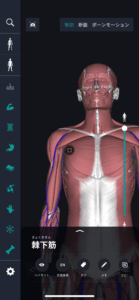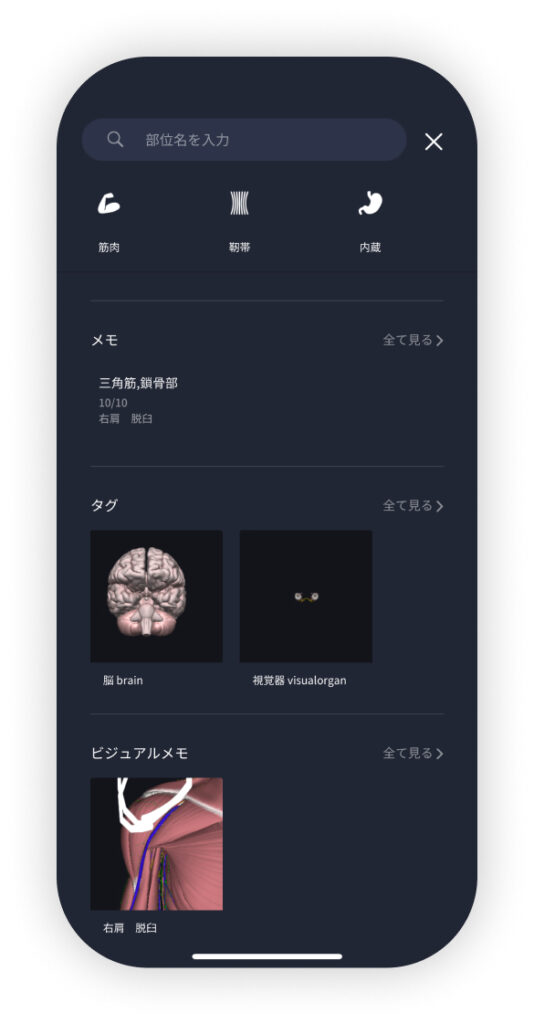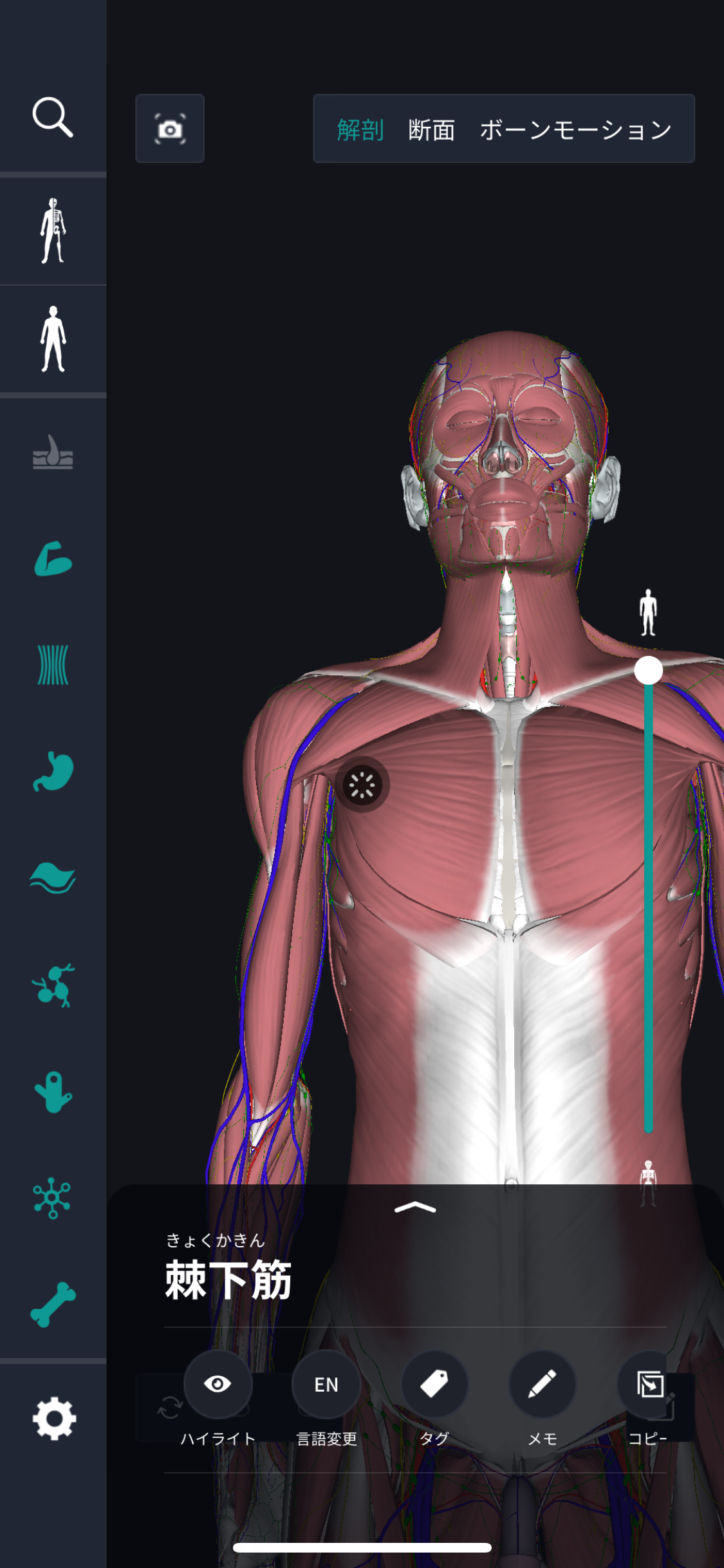beginning
In this article, I will explain effective study methods, starting with knowledge of specialized parts in human anatomy.
In human anatomy, it is necessary not only to memorize the names of various organs, muscles, and bones, but also to remember where they are located in the body. Therefore, it is necessary to learn as efficiently as possible.
I hope you can read this article and use the app to deepen your understanding even a little bit.
Now, I'll explain the details about the “subspinous muscle” and how to study human anatomy.
What is the subspinous muscle?
In the anatomy application, you can view a selection of anatomy 3D models. In this model, there are various observation methods such as surfaces, cross-sections, and nervous systems. This time, I'll explain using an anatomy application.
About the hypospinatus muscle

Study points
Infraspinatus muscle location and structure
The infraspinatus muscle (infraspinatus muscle) is a muscle located in the infraspinous fossa (infraspinous fossa) of the scapula and forms part of the rotator cuff. It is a fan-shaped muscle that extends to the back surface of the scapula, and the starting part is in the subspinous fossa. The end part attaches to the back surface of the large tubercle of the humerus, and this is responsible for external rotation of the shoulder joint. The shape of the subspinous muscle is flat and widened, and the muscle fibers run diagonally from the lower part of the scapula to the large tubercle. The minor muscles that attach to the upper part of the shoulder blades are adjacent, and both participate in complex shoulder movements. This muscle extends to cover the entire back side of the shoulder blade, and it is characteristic that the upper part is in contact with the spines of the shoulder blade. It is controlled by the suprascapular nerve (suprascapular nerve) and originates from the 5th and 6th nerve roots of the cervical spine. Blood supply is carried out through the rotator scapula artery, which supports muscle activation and oxygen supply. The subspinous muscle, along with other muscles, contributes to stabilizing the shoulder joint and enables a variety of shoulder exercises.
The role and function of the subspina muscle
The infraspinatus muscle (infraspinatus muscle) plays an important role in the movement of the shoulder joint. It is mainly involved in external rotation of the shoulder joint and is responsible for the movement of rotating the arm outward from the body. This is essential for sports pitching movements and arm rotation movements in everyday life. As part of the rotator cuff, the hypospinatus muscle also has the function of increasing the stability of the shoulder joint. The shoulder joint has a wide range of motion and is a structure that makes it very easy to move, so muscles that stabilize the joint are important. The subspinous muscle attaches to the large tubercle of the humerus bone and works with other rotator cuff muscles (supraspinatus muscle, small circle muscle, subscapula muscle) to attract the humerus bone to the joint socket and maintain the proper position of the shoulder joint. Furthermore, the subspinous muscle works in coordination with other muscles at the beginning of shoulder movement and during sustained arm movement. This allows the shoulder to move more smoothly and reduces strain. This muscle function is particularly important for athletes who overuse their shoulders and people in occupations that use their hands a lot.
English notation for hypospinatus muscle
Infraspinatus muscle is written as infraspinatus muscle in English. The term hypospinatus muscle is broken down into English as follows. Infraspinatus: It is expressed as infraspinatus in English. This means “below the spine,” and it is named because it is located in the subspinous fossa of the scapula. Muscle: In English, it's expressed as muscle. This is a general term for the structure of the body and means “muscle.” Therefore, when the hypospinatus muscle is expressed in English, it is infraspinatus muscle.
How to study human anatomy
I will explain specific study methods using human anatomy applications.
Check your past learning history and practice repeatedly
Here are the steps to check your anatomy learning history and practice iteratively effectively.
1. Check your learning history in the app
Reviewing your learning history with the application is an important step in effectively advancing anatomy learning. First, launch the app and go to the learning history section from the main menu. Many anatomy apps are designed to show your progress in the form of graphs and lists, so you can visually check which parts you've learned about and how much time you've spent.
By using this data, you can understand which areas you have strengths in and where you need to spend more time and effort. We also recommend using a dedicated tag or notebook function to mark areas you are particularly weak at or where you need to relearn. Regularly checking your learning history and looking back on past learning content will lead to efficient review and deepening understanding.
2.Make a plan for iterative learning
Making an efficient repetitive learning plan based on learning history is extremely effective in promoting knowledge retention. First, identify weak points and areas where you need to relearn. Next, arrange these study items into a weekly or monthly calendar and create a specific study schedule. By proceeding in a planned manner, you can learn each part evenly and avoid packing in a large amount of information at once.
Using a task management app or digital calendar to set study reminders is effective. Also, it's important to have the flexibility to regularly review progress and revise plans as needed. By having goals and proceeding with your studies in a planned manner, you can efficiently acquire anatomical knowledge.
3.Use 3D features to learn visually
By utilizing the 3D function, learning anatomy is easier to understand visually. The 3D model shows the structure of the human body three-dimensionally, and each part can be observed in detail. This makes it possible to intuitively grasp positional relationships between deep muscles and organs that are difficult to capture in a planar view. For example, you can learn even the smallest details by rotating specific muscles and bones and zooming in and out.
Also, there are many apps that have the function of displaying cross-sectional views of each part using a 3D model, which is useful for deepening understanding of internal structures. This diversity of visual information helps with memory retention and improves immediate responsiveness in tests and practice situations. By utilizing the 3D function and learning visually, you can learn anatomy knowledge more deeply and efficiently.
Use the memo function concretely

Test your learning regularly in the form of quizzes
Regularly testing what you've learned in a quiz format is a very effective way to anchor your anatomy knowledge. Quiz-style tests help you objectively grasp your level of understanding and areas you lack while repeating knowledge.
For example, by using a learning app to conduct quizzes every specific period, you can reconfirm what you've learned and strengthen your memory. There are a wide range of quiz formats, such as multiple choice questions, fill-in-the-blank questions, and short answer questions, and each helps understanding from a different angle and develops the ability to utilize various types of knowledge.
Get feedback
If possible, get feedback from other learners and experts. It helps you find your own gaps in understanding and areas for improvement. You can also keep yourself motivated to learn by regularly testing yourself. Feeling a sense of accomplishment and progress increases motivation for continuous learning.
summary
This time, I explained how to study “subspinous muscle” using an application!
Thank you for reading this far.
I would be happy if reading this article helped you learn about anatomy.
Learning is a long, never-ending journey, but I sincerely wish you all the best. Let's continue to study together and work hard for the national exam!
Please look forward to the next blog.




